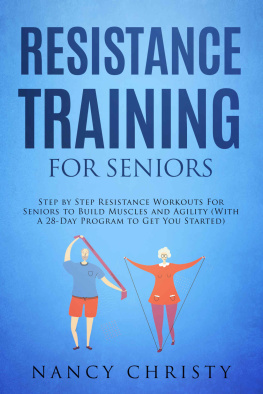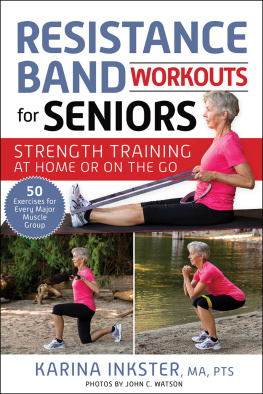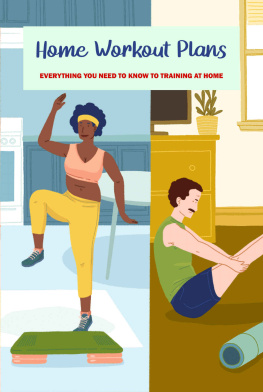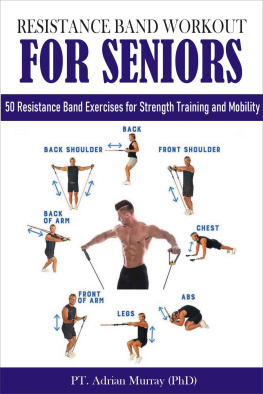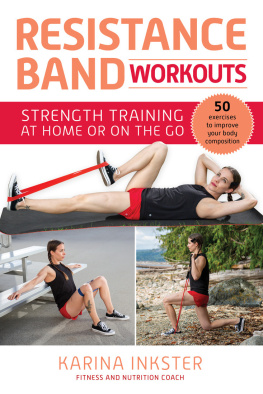RESISTANCE BAND WORKOUT
Learn The Most Complete Stretching And Strength Exercises
Using Resistance Bands. 101 Exercises To Get Fit, Build Muscles And Decrease Body Fat At
Home | 31-Days Workout Plan
Nathan Merrick
Table of Contents
Introduction
Resistance training uses resistance to muscular contraction to build strength and skeletal muscle mass.
These workouts achieve this using:
- Free Weights : Here, you train with tools like Barbells, kettlebells, and dumbbells.
- Resistance Bands : You can use them anywhere since they are portable and adaptable to most exercises. When you stretch them, the resistance bands give a constant resistance throughout a movement.
- Weight Machines : Here, you get to work out with machines such as a low-pulley cable bench, leg extension machine, leg press machine, lat pulldown, chest press machine, and pec deck. These weight machines will strengthen your muscles when you lift or push using your arms or legs.
- Your Body Weight : Using your own body for resistance training can be effective too. Some workouts that fall here include push-ups, sit-ups, lunges, step-ups, and squat thrusts.
- Suspension Equipment : Here, handles on each end of a band are mounted above your head level so you can work and move against your body weight.
According to a study , only a few senior adults participate in resistance training, despite its many benefits. Still, even those who do such workouts only do them a few times and not regularly.
Some of the reasons for this include:
- Health Issues : Chronic illnesses can keep you from training because you may fear sickness, pain, or simply assume that you cannot work out.
- Fear of Injury : You may fear falling, getting hurt, and generally feel unsafe when handling machines mainly because you feel your body is incapable.
- Tiredness or Fatigue : Old age comes with being tired easily.
- Lack of Social Support : You may lack support from family and friends who feel that resistance training is too difficult for you.
Why is Resistance Training Great for Seniors?
As you age, even in the absence of a health condition, you are most likely to experience various biological changes that have the potential to result in decreased skeletal muscle strength and mass.
I believe you have watched at least one of Sylvester Stallone's movies. Well, the famous Rambo actor has always looked good. After many years of acting, you would think it is time for him to retire, considering he is 74 years old, but he is still strong and gracing our screens with more movies.
According to fitandwell.com , Sylvester Stallone trained by lifting logs and punching meat in an abattoir. Also, in an Instagram post, he says that he used to work out with weights. However, over the years, as he aged, he found that the resistance bands were more comfortable and safer for him. But the bottom line is that he still engages in resistance training.
Sylvester Stallone has been performing resistance training exercises for as long as he has been acting! Also, resistance training is part of his regular workout, whether weights or resistance bands. This further shows that resistance training is safe for people above 50 years. At his age, however, having moved from weights to resistance bands is an indication that as you continue aging, your choice of resistance training exercises depends on how comfortable you are.
That said, here is why resistance training is great for you;
- Increases Muscle Mass and Strength : Your muscle strength and mass gradually decrease as you age. Based on a particular study , resistance training alone results in stronger muscles in frail older adults than other combined exercises like jogging, hill walking, cycling, and walking without resistance training. Thus, training at an intensity close to 60% to 85% of your maximum voluntary strength will increase your muscle mass and strength.
- Improves Metabolism : Research shows that your metabolism slows down as you age. Muscle loss, being less active, and the aging of your internal components contribute to a drop in metabolism. Having more muscle mass increases your resting metabolism, which is important because the more calories you burn at rest, the more you will maintain a healthy weight.
Luckily for you, resistance training is great for building muscle mass. Also, it is effective in reversing the risk factors causing metabolic problems and low-grade inflammation. These risk factors include obesity, insulin resistance, physical inactivity, and genetic factors.
- Reduces Chances of Suffering from Chronic Conditions : Research ers set out to determine if resistance training is a primary countermeasure to age-related chronic disease.
The study showed that resistance workouts effectively reduce the risk of several chronic diseases such as cardiovascular disease, cancer, and diabetes type 2, which are now a leading cause of mortality and morbidity for seniors aged 65 years and above.
- Reduces Physical Discomfort : As you age, you are likely to experience physical discomforts such as lower back pain, joint pain, and stiffness. Common causes of physical aches include osteoarthritis, osteoporosis, and rheumatoid arthritis. Particularly, if you have osteoporosis, you cannot perform weight-bearing exercises such as running, hiking, climbing stairs, high-impact aerobics, and jogging. This means you need to incorporate exercises that are friendly to weakened bones to reduce more fractures.
Resistance training exercises, including biceps curl, shoulder lifts, hamstring curls, hip leg lifts, and squats, are friendly with seniors living with these physical discomforts. They reduce pain associated with these conditions by increasing skeletal muscle mass and strength.
- Increases Bone Density : Do you want to have stronger, healthier bones even at old age? I believe you do because strong bones can help reduce the risk of age-related decline in bone mass. Usually, bone density increases when you put stress on bones. According to a study , the best bone-building workouts are resistance training exercises and weight-bearing exercises.
Other exercises such as cycling and swimming have their benefits but are not the best for increasing bone density. You can do the workouts using free weights, including dumbbells and kettlebells, barbells, resistance bands, medicine balls, or your own body weight resistance exercises such as push-ups, squats, lunges, abdominal crunches, and toe stands.
- Improves Cognitive Function : The memory you had at 18 will not be the same at age 65. As you grow older, you may experience mild cognitive impairment, which involves a decline in memory and thinking skills like predicting, evaluating, analyzing, and problem-solving.
Research ers set out to determine whether resistance training can protect the brain from degeneration. A hundred participants at high risk of Alzheimer's disease due to mild cognitive impairment were split into four groups and given tasks including strength training, computerized brain training, combined computerized brain and strength training, and a control group.
Those who participated in strength/resistance training using dumbbells, weights, or machines had better cognitive outcomes than the rest after training for six months. Also, they trained for 45 minutes, twice a week. Among the findings, the hippocampus, a major part of the brain that plays a role in memory and learning, and its sub-regions, were protected from degeneration and shrinkage for up to 12-months after the resistance training.
- Improves Mobility : As you grow older, things like walking, sitting, or standing are no longer easy to do. Despite this, it is still important to maintain mobility to function independently as you age. Incorporating resistance training into your workouts will improve mobility because these workouts are great for building muscles and strength.
Next page


